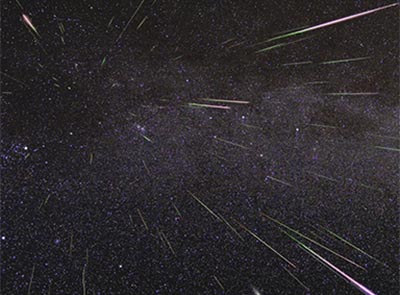Make plans now to stay up late or set the alarm tonight to see a cosmic display of “shooting stars” light up the night sky.
Known for its fast and bright meteors, the annual Perseid meteor shower is anticipated to be one of the best potential meteor viewing opportunities this year.
The Perseids show up every year in August when Earth ventures through trails of debris left behind by an ancient comet. This year, Earth may be in for a closer encounter than usual with the comet trails that result in meteor shower, setting the stage for a spectacular display.
“Forecasters are predicting a Perseid outburst this year with double normal rates on the night of 11 to 12 August,” says Bill Cooke with NASA’s Meteoroid Environments Office. “Under perfect conditions, rates could soar to 200 meteors per hour.”
An outburst is a meteor shower with more meteors than usual. The last Perseid outburst occurred in 2009.
Every Perseid meteor is a tiny piece of the comet Swift-Tuttle, which orbits the sun every 133 years. Each swing through the inner solar system can leave trillions of small particles in its wake. When Earth crosses paths with Swift-Tuttle’s debris, specks of comet-stuff hit Earth’s atmosphere and disintegrate in flashes of light. These meteors are called Perseids because they seem to fly out of the constellation Perseus.
Most years, Earth might graze the edge of Swift-Tuttle’s debris stream, where there’s less activity. Occasionally, though, Jupiter’s gravity tugs the huge network of dust trails closer, and Earth plows through closer to the middle, where there’s more material.
This may be one of those years. Experts at NASA and elsewhere agree that three or more streams are on a collision course with Earth.
“Here’s something to think about. The meteors you’ll see this year are from comet flybys that occurred hundreds if not thousands of years ago,” says Cooke. “And they’ve traveled billions of miles before their kamikaze run into Earth’s atmosphere.”
Spacedex advises South African stargazers to find an area unobstructed by a structure that is far away from city lights.
Using optical devices such as binoculars or telescopes is not recommended, as the field of view will be greatly restricted, thus making the possibility of missing a “shooting star” more likely.
Observers should face half-way up toward the northeastern portion of the sky, where the constellation of Perseus, and the radiant of the Perseids shower, will be within view.
While an impressive Perseid display is expected, it might be faint since it co-incides with a waxing gibbous moon.
Pictured: An outburst of Perseid meteors lights up the sky in August 2009 in this time-lapse image. Stargazers expect a similar outburst tonight.
Credits: NASA/JPL

